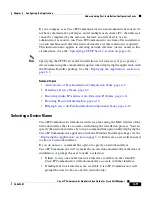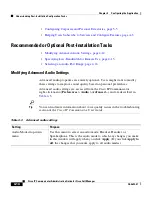
Chapter 4 Configuring the Application
Understanding Post-Installation Configuration Tasks
4-10
Cisco IP Communicator Administration Guide for Cisco CallManager
OL-4698-01
Choosing the correct interface is critical because Cisco IP Communicator uses the
MAC address of the associated network interface to identify its device name to
Cisco CallManager in the same manner as hardware-based Cisco IP Phones.
Therefore, every time Cisco IP Communicator starts, it verifies that the
associated interface is still installed in the machine. This prevents users from
modifying Cisco IP Communicator’s original device name.
With multiple network interfaces
When multiple network interfaces exist—such with a laptop that uses both a
wireless (802.11) and wired (Ethernet) network interface, or a laptop with a
docking station—advise users to choose the interface that is most likely to provide
permanent connectivity, or the one that is always enabled (even if it is inactive).
In most cases, this means choosing an integrated Ethernet card over a wireless
card, docking station, or PC card. (Wireless cards are to be avoided because they
can appear disabled if they are not associated with a base station.) Ideally, you
should tell users exactly which network interface to choose.
Note
At first launch, Cisco IP Communicator automatically chooses an Ethernet
interface, if one is present. Because some laptop docking stations contain
additional Ethernet interfaces, advise laptop users to undock before launching
Cisco IP Communicator for the first time. Doing so will help
Cisco IP Communicator choose the appropriate network.
With a shared PC
If your company uses Cisco IP Communicator in an environment where users do
not have administrative privileges, and if multiple users share a PC, a user cannot
select the device name. Instead, you will need to use an administrator account to
run Cisco IP Communicator one time after installation on each machine and
select the network interface (if this selection is required). This instruction also
applies to selecting a TFTP setting in this circumstance, if one is required. (See
the
“Specifying a TFTP Server” section on page 4-8
.)
After disabling or removing an interface
If the associated network interface is later disabled or removed,
Cisco IP Communicator will prompt the user to either reinstall the interface or
choose a new interface. If you or the user chooses a new interface, you must create
a new device record in Cisco CallManager to preserve the user’s original DN,
softkey template, settings, and so on. Delete the old device record.
Содержание IP Communicator
Страница 8: ...Contents viii Cisco IP Communicator Administration Guide for Cisco CallManager OL 4698 01 ...
Страница 23: ...xxiii Cisco IP Communicator Administration Guide for Cisco CallManager OL 4698 01 Preface Document Conventions ...
Страница 24: ...Preface Document Conventions xxiv Cisco IP Communicator Administration Guide for Cisco CallManager OL 4698 01 ...






























